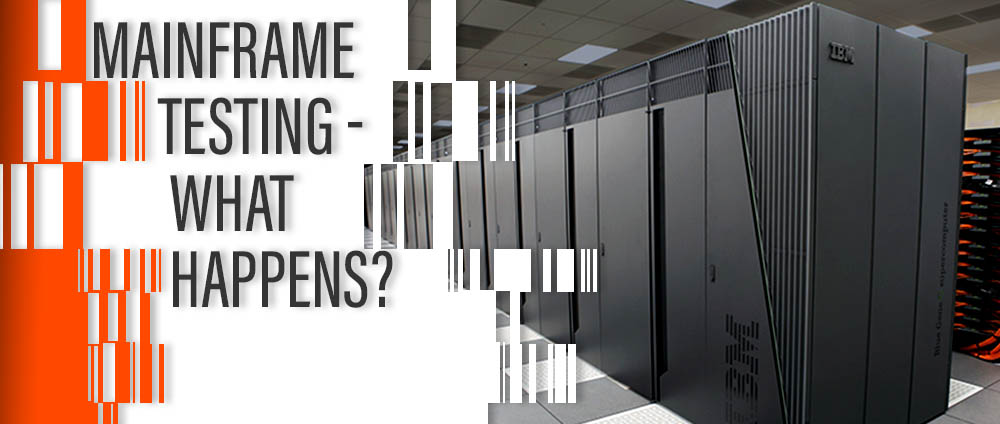
Mainframe Testing – What Happens?
February 12th, 2019

Here is everything that you need to know about Mainframe Testing – what it is and what is the process that is followed, essentially a complete beginner’s guide to Mainframe Testing.
What is Mainframe Testing?
Mainframe Testing is the process of testing Software Services and Applications that are based on the Mainframe Systems.
The process is crucial part of the Application Development Process as it is instrumental in adhering to the cost and quality standards of the industry.
Mainframe Testing ensures that the system is in fact, ready to be launched in the market.
What are the steps followed while undertaking Mainframe Testing?
- Smoke Testing – Also known as Shakedown, this is the take-off point of the process of Mainframe Testing. Before any action is taken on the codes that are to be used, this first step is to ensure that all the codes that have been deployed are actually in the right testing environment.
- Only after the adaptability of the code has been confirmed, and the codes checked for any critical technical glitches, are they approved to be worked on in the later stages of the Mainframe Testing Process.
- System Testing – This stage involves a series of testing that is undertaken to test the functionality of individual systems that comprise the Mainframe system, as well as their performance with respect to each other.
- Batch Testing – The Batch Jobs begin by testing the scope of data and files, recording the results and making changes wherever necessary. The Batch Testing is the stage where the validation of the test results on output files and data as done by the batch jobs take place.
- Online Testing – While the Batch Testing can be loosely understood as the back-end testing phase, with Online Testing, the testing moves to the front end of the mainframe application. The Mainframe Application is tested here in relation to the entry fields that are used by the system.
- Online-Batch Integration Testing – This stage bridges the gap between the back-end and the front-end of the Mainframe System. Through this integrative testing, the data flow, as well as the interaction that takes place between the online screen and the batch job, is validated and approved before being passed on to the next stages of the Mainframe Testing process.
- Database Testing – At this stage, the database of all data for the Mainframe Application is stored is validated for the layout of the data storage.
- System Integration Testing – Once the basics have been covered, System Integration Testing is initiated to test the functionality of the system under test and their response to, as well as their interaction with other systems. This is rather a broad spectrum and is prone to be considered as unnecessary, but it is an essential step as it ensures that the new system integrates with other systems in an organized manner.
The relationship between the different systems here is not in terms of either being affected by the requirements of the other.
But in the sense that each use data that is being collected, stored or managed by the other systems.
Hence, testing the exchange of data takes place, and how commands and results flow from one system to the other is essential to create a streamlined integration process between different systems.
Again, the different types of testing processes that are used for System Integration Testing are Batch Testing, Online Testing and Online-Batch Integration Testing (as discussed previously).
- Regression Testing – This can be understood as the counteractive stage to the previous one. While the System Interaction Testing ensures that the different systems that comprise the Mainframe function simultaneously and are conducive to the performance of the System as a whole, the Regression Testing is a way to ensure that the different systems do not hinder the performance of each other.
Each system should not only be involved in the functioning of the other, as long as it is beneficial for both of the systems. Therefore, Regression Testing is responsible for making sure that the batch jobs or online screens, for instance, do not negatively affect the system that is currently being reviewed or vice versa.
- Performance Testing – Once we know that each system that is currently at work is doing its job in relation to the new system, or an update being tested and that the new system under test does not hamper the functionality of an existing system, the next step is to test the performance of the system in its specific environment. It involves identifying bottlenecks in high hit areas like the front end data, or other activities like upgrading online databases and to check and understand the scalability of the application.
- Security Testing – When it comes to software or well any Technology for that matter, the first question that needs to be answered is whether it is a secure platform or a safe space for the users. The same goes for the Mainframe Testing process. Before approving it for being used in the system, it is important that the system is tested to see how it fares against the security attacks. Security Testing is a stage that evaluates the design and development of the application and its ability to withstand potential security attacks. It includes the system’s independence in countering those attacks and keeping all information and data entrusted to it, absolutely safe. The two most common types of Security Testing that need to be undertaken are the Mainframe Security and Network Security. The features that both these tiers of security tests, check in their specific ways are – Integrity, Confidentiality, Authorization, Authentication, and Availability.
This is the basic model that is followed by testers when it comes to Mainframe Testing.
While specificities might vary depending on the particular project at hand, the basic outline that is to be followed remains the same. As with every other aspect of Technology, there is enough room to negotiate or experiment with this industry standard.
Experimenting and exploring unchartered territories though might lead to dead ends or tunnels that don’t always end with light.
But you can always trace your steps back, and find out where you went wrong and take corrective measures as and when required.
The next section focuses on the challenges or problems that are faced by the Mainframe Testing team and how can they find their way out of a tight spot.
What are the common challenges faced in the process of Mainframe Testing?
Each and every kind of Testing is a series of hit and trial until you arrive at the best possible system. Mainframe Testing is no different. Though we have discussed the steps that are generally followed during the process of Mainframe Testing, even the closest adherence to these steps do not always ensure the best solution in the first attempt.
There will always be challenges or troubleshooting that the testing team will be faced with during the process.
Discussed below are some issues that have been often reported by the testers and the possible approach that can be adapted to find a solution to that problem.
- Unclear Requirements
Problem – It is extremely important to have clearly set requirements before you working on any testing project. While a supporting manual might be available, it does not always cater to the demands and needs of the project at hand. The problematic of unclear, incomplete or impractical documentation is a problem that hinders the testing process.
Solution – The testing team should be actively involved in the Software Development Life Cycle right from the time when Requirements are being set for the system. Their involvement in the early stages will ensure that they can verify that the requirements that are being set are after all testable and practical. This saves time, money and efforts of the team, while also ensuring that the Software Development Process does not come to a standstill at a later point in the testing phase.
- Ad-hoc Request
Problem – it may so happen that upstream or downstream application issues might necessitate end-to-end testing needs. These unexpected requests have the potential to disrupt the pre-defined schedule of the testing process by increasing the time, efforts and other resources required in the execution cycle.
Solution – To provide for the unforeseeable issues during the testing process, it is advisable to have automation scripts, regression scripts, skeleton scripts and any other backup plans to implement immediately as and when faced with a problem. This considerably reduces the overall time and efforts required for the completion of the project.
Here goes your basic guide to Mainframe Testing. This is not an exhaustive guide, there is always more that we can learn, and there is always room for improvement and efficiency. Keep exploring.


 Software Testing Events
Software Testing Events App Testing
App Testing Web App Testing
Web App Testing Game Testing
Game Testing Automation Testing
Automation Testing Load Testing
Load Testing Security Testing
Security Testing Performance Testing
Performance Testing Hire a Tester
Hire a Tester







